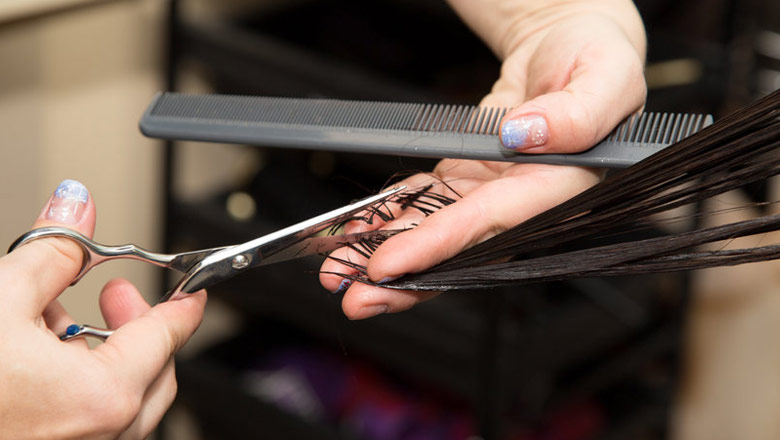
Most articles say that your professional shears are a hair stylist’s most important tools, but I’d argue it’s your hands. Tools can be replaced but your hands do all the work and need to be protected from repetitive injuries so you can have a long and enjoyable career.
That means there are two vital things needed from quality professional shears: good blades and ergonomic handles because the perfect shears both cut well and support your body. Keep upgrading your salon with the best styling chairs around.
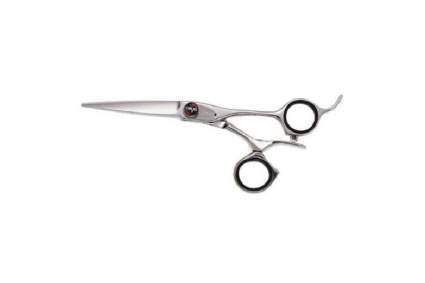
|
Amazon Customer Reviews
|
Price: $599.95 Shop at Amazon | Shop now Read our review |
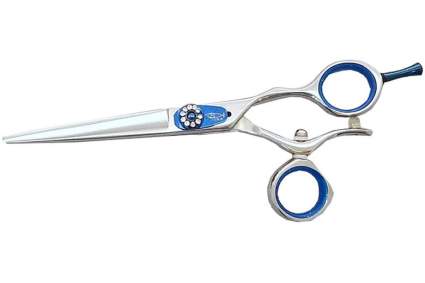
|
Amazon Customer Reviews
|
Price: $198.00 Shop at Amazon | Shop now Read our review |
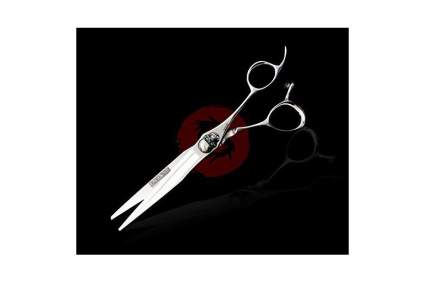
|
Amazon Customer Reviews
|
Price: $385.00 Shop at Amazon | Shop now Read our review |

|
Amazon Customer Reviews
|
Price: $149.00 Shop at Amazon | Shop now Read our review |
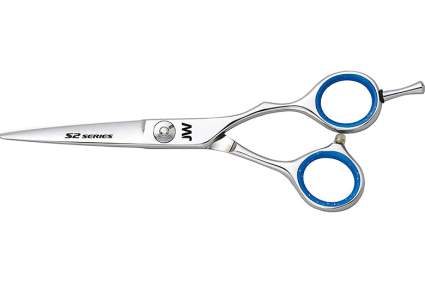
|
Amazon Customer Reviews
|
Price: $99.99 Shop at Amazon | Shop now Read our review |
-
1. Most Ergonomic: Sensei Revo Salon Shears
Pros:- Crane handle with rotating thumb
- Long-lasting steel alloy and cryogenic temper
- Reversible ball-bearing tension system
- Convex blades
Cons:- Bigger investment up front
- Heavier than others
- Crane-style can take time to get used to
The Revo by Sensei has basically everything you could want. Its convex blade design is forged from Japanese steel with molybdenum, vanadium, and cobalt to improve rust resistance, durability, and hardness.
Forged blades are generally shaped at over 1000 degrees Fahrenheit and brought down to about 32 degrees quickly to temper them. Sensei goes a step farther and cools their blades with liquid nitrogen, bringing them down to -300 degrees slowly.
To sum up a lot of science-y articles I read (like this 2019 study published in Materials), Temperatures this cold have a huge effect on the structure of the steel molecules. It makes the metal much more stable, long-lasting, and hard without making it brittle. Sensei has a video on Vimeo showing how their methods work.
In another effort to prolong the life of the scissors, the Revo has a built-in polymer glide at pivot ride that prevents the blades from rubbing against each other. The pivot has a reversible ball-bearing tension system that creates better stabilization and a smoother pivot. Being reversible means you can pull out the tension system and switch it to other side for more comfortable left-handed use.
As far as ergonomics, Revo has a strong crane-style curve to the handle which lets you keep your elbow down as well as a swiveling thumb with 360 degrees of turn. The swivel uses a ball-bearing so you won’t have to fight to move it around.
Find more Sensei Revo Salon Hair Shears information and reviews here.
-
2. Best Rotating Thumb: Bonika Silk Twisters
Pros:- Japanese steel convex blades
- Rotating thumb
- Best for heavy-handed stylists
- More affordable
Cons:- Dye-cast instead of forged
- Older model
- Not for detail work
If you’re on a budget but still want something ergonomic, the Silk Twister by Bonika is a good pair of shears with nice features but at a reduced cost because it’s cast in Japanese stainless steel instead of hand-forged. While cast shears don’t get the same level of hands-on attention, that doesn’t mean that they can’t be quality professional shears.
The strong convex blades are built for holding up to fast-paced, dramatic cutting. This isn’t for your detail work–this is for your jaw-dropping transformation work.
The Twister has an offset handle and 360 degree rotating thumb so you can reduce wrist strain and keep your elbow down. To make sure your shears are functioning how you want them, there’s an easy twist knob for the tension system so you don’t have to worry about finding your key when you’re in the middle of a cut.
Find more Bonika Silk Twisters information and reviews here.
-
3. Most Long-Lasting: Kamisori Typhoon Professional Haircutting Shears
Pros:- Hand-forged Japanese Molybdenum Steel
- Ball-bearing tension system
- Convex blade
- Skull accent with crystals
Cons:- Not everyone's into the skull
- Too big for some
- Bigger investment up front
These Seven-Inch Kamisori Typhoon Shears aren’t messing around and the skull makes that very clear. They’re so sharp and durable I think it would be safe to call them hardcore. The skull with green crystal eyes hides a ball-bearing tension system that stabilizes the blades and has a smoother pivot than traditional washer tension systems. It’s the sort of thing you’d expect to see next to a trendy vintage barbershop chair.
The Typhoon is forged by hand (instead of dye cast) and is made of steel blended with molybdenum, an element that makes the steel more rust-proof, less brittle, and harder than steel alone. The Rockwell rating system is a means to show how hard a metal is based on how much pressure it takes to dent it with a diamond. Quality steel shears typically land around 58 or 59 and the Typhoon is a 60.
All this means is that the convex blade on these can hold a sharper edge and hold that edge longer than softer steel alloys. That does make them slightly more brittle compared to steels with a lot of flex to them so if you’re the type of person who drops their shears on the floor about six times a day, these might not be for you. But if you treat these well, they can still be with you 20 years from now.
They also come in a 6.5-inch size.
Find more Kamisori Typhoon Professional Haircutting Shears information and reviews here.
-
4. Best Japanese Shears: SakiTomika Hairdressing Shears
Pros:- Removable thumb rest
- Convex blade style
- Rockwell hardness of 60-61
- Handmade
Cons:- Not as curved as some crane-style shears
- A little too pink for some
- Heavier than some
The Tomika Shears by Saki are straightforward, no-nonsense 5.5-inch shears perfect for professionals who aren’t looking for bells and whistles. It’s a quality baseline to build your shear preferences on.
They feel amazing with a smooth, effortless pivot. They have a classic look to them that isn’t flashy and the cute pink accents give them a memorable look.
The convex blades are made of Japanese stainless steel alloy with a Rockwell Hardness of over 60. These are very hard, but Saki doesn’t list the metals they use in the alloy which would be helpful for measuring their balance of durability and brittleness.
The Katana shears come with their own black case.
Find more Saki Tomika Hairdressing Shears information and reviews here.
-
5. Most Affordable Joewell S2 Professional
Pros:- Affordable
- Japanese stainless steel
- Ergonomic offset handle
- Many sizes
Cons:- Not as high quality as others
- Glitter finger insets aren't for everyone
- Offset is slight
- Made in China
JW S2 Shears are a good choice when you’re just starting out and need something that won’t break the bank. While it might not make sense to drop a ton of money into top of the line shears until you’ve established a regular customer base to recoup your investment, that doesn’t mean that you should be working with cheap scissors until then or your cuts will both take you longer and not be as consistent.
You want something in the middle–not cheap but not top-notch. These shears from JW are a good compromise of quality and price with Japanese steel and convex blade design but at a price that’s easy to justify if you’re just starting your career or if you’re on a tight budget for any other reason.
The offset handle makes them comfortable to use and the finger grip inserts are a nice blue with silver glitter–which can be a good or bad thing depending on your opinion of glitter.
These come in several sizes from five inches to seven inches as well as with a case with slots for eight tools. It’s a really good value for your money so if you’re looking to spend under $200, this is a good bet.
Find more Joewell S2 Professional information and reviews here.
Which Are the Best Hair Cutting Shears For Me?
It entirely depends on your preferences, hand size, and ergonomic needs. Different handle shapes help you keep your preferred hand position with less strain.
Haircutting is a little bit of an ergonomic nightmare of standing for long hours performing repetitive motions. The most important thing is to find shears that support your body. If you have sore feet at the end of the day, it's time to switch up your anti-fatigue barber mats.
What Are the Different Handle Styles?
Shears that cut like a dream aren't worth anything if they're painful to use. It's important to choose a handle style that allows you to work without straining your wrists.
Opposed handles have grips that are straight and equal. They aren't ergonomic at all. Avoid them if you can.
Offset handles have a shorter thumb, allowing for a more natural curve and removing some of the burden from your wrist. They let you work without raising your elbow as high, which your whole body will thank you for.
Crane-style handles take the offset design and bend it to remove even more stress from the wrist and elbow.
Swivel thumbs have rotating thumb rings that allow you to customize your thumb angle so you can hold your hand in whatever position is best for you.
To read more on the importance of ergonomics for stylists, check out this article by Modern Salon.
Should I Get a Beveled or Convex Blade??
The majority of scissors in the world are beveled which means the sharp edge of the blade is created by a sudden angle near the edge of the blade. They're cheaper to produce but don't cut as smoothly and aren't great for slide cutting.
Convex or clamshell blades can hold sharper edges and require less force because the cutting angle runs the whole width of the blade. They tend to be more expensive but deliver a softer, blended look.
What About Hairdresser Shears for Kids?
For the most part, your tiny clients can use the same shears as your adult clients but if they are scared of big scissors or have sensory issues, there are options for more kid-friendly salon tools.
How Do I Take Care of My Hair Cutting Shears?
Maintaining your shears helps to preserve your investment and keep them working for you for years to come. Check out the Paul Mitchel MTI College suggested daily cleaning and oiling routine.